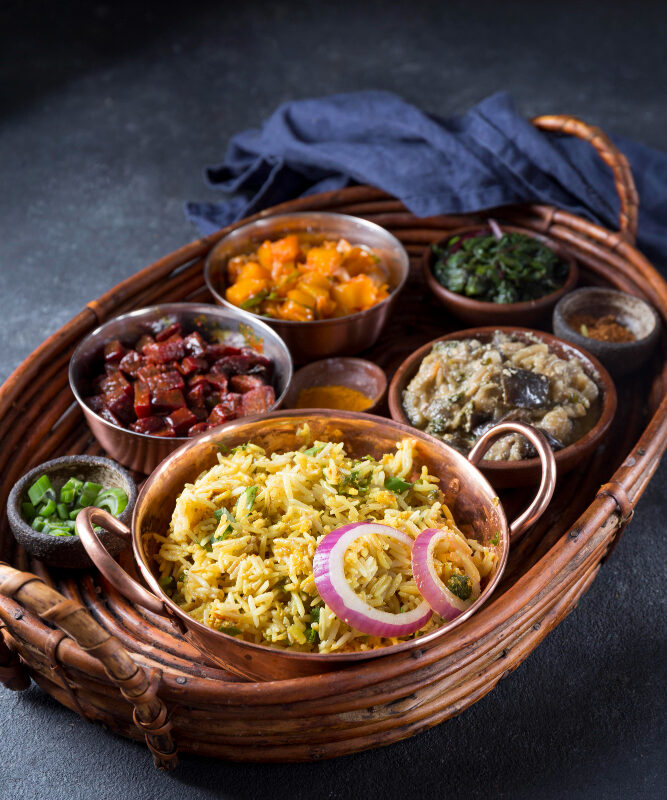
Welcome to a delightful exploration of traditional Indian dining! Indian cuisine, known for its vibrant flavors and diverse dishes, offers more than just a meal; it’s a cultural experience. But to truly appreciate its essence, understanding the traditional ways of enjoying Indian food is key. Whether you’re dining at authentic Indian restaurants or trying homemade recipes, this guide will walk you through the nuances of traditional Indian eating practices.
Understanding the Basics of Indian Meal Structure
A traditional Indian meal is a symphony of flavors and textures, thoughtfully composed to offer a complete sensory experience. Central to this meal structure are staples like rice and bread. Rice, often basmati, serves as the foundation for many dishes and is prized for its delicate flavor and aroma. Breads, such as naan and roti, are not just accompaniments but integral components, used to scoop up curries and gravies.
The main dishes, often a mix of vegetarian and non-vegetarian options, range from rich, creamy curries to grilled tandoori items. Accompanying these are side dishes like dals (lentils), chutneys, and pickles, adding layers of flavor – from tangy to spicy. Understanding this composition helps one appreciate the balance and variety in a traditional Indian meal.
The Art of Eating with Hands
In many parts of India, the tradition of eating with hands is not just a practice but a philosophical approach to dining. It’s believed that eating with your hands engages all your senses and enhances the dining experience. The technique is simple yet elegant: typically, food is gathered with the fingertips and pushed into the mouth with the thumb. This method is most effective with foods like rice mixed with curry or soft bread like roti.
Eating with hands is also thought to connect the body and mind to the act of nourishing oneself, creating a more intimate and mindful eating experience. Moreover, it’s said that the fingers can sense temperature, texture, and even spice levels, helping to prevent burns or discomfort from overly spicy food.
Navigating the Spice Palette
Indian cuisine’s hallmark is its masterful use of spices. These spices are not just used for heat but are carefully selected and blended to create complex flavor profiles. Understanding these spices is key to appreciating Indian cuisine. For instance, cumin adds earthiness, while cardamom brings a sweet fragrance. Turmeric offers a warm, bitter note and is known for its health benefits, and red chili powder provides heat. Spices are often tempered in oil to release their flavors, a technique known as tadka.
This section will not only introduce the commonly used spices and their characteristics but also offer tips on how to enjoy and balance these flavors, especially for those who are less accustomed to spicy food. This understanding enriches one’s appreciation of the depth and sophistication inherent in Indian culinary practices. For more details visit us at https://thecurryrestaurant.com/.
The Role of Sweets and Desserts in Indian Cuisine
Sweets and desserts in Indian cuisine are not merely an end to a meal; they are a celebration of taste and tradition. Indian sweets, known as ‘Mithai’, are often rich and decadently prepared with ingredients like milk, sugar, nuts, and ghee (clarified butter). They range from syrupy confections like Gulab Jamun to milk-based desserts like Rasgulla. Desserts also carry cultural significance, often being integral to festivals and celebrations.
Understanding the variety and the context in which these sweets are enjoyed offers a glimpse into the joyous and communal spirit of Indian dining. Additionally, the timing and pairing of these sweets with the meal can be unique – sometimes served alongside the main course or as a standalone treat.
Beverages: Complementing the Flavors of Indian Cuisine
Beverages in Indian cuisine are as varied and nuanced as the food itself. From the spiced warmth of Masala Chai, a tea brewed with a mixture of aromatic spices and herbs, to the cooling Lassi, a yogurt-based drink often flavored with fruit or spices, these beverages are carefully chosen to complement the meal.
In a traditional setting, these drinks are not just refreshments but integral parts of the meal, aiding digestion and enhancing the overall dining experience. Understanding the role of these beverages, and when and how they are consumed in relation to the food, provides a more complete understanding of the traditional Indian dining experience.
Dining Etiquette and Cultural Norms in Indian Dining
Indian dining is not just about food; it’s about tradition, respect, and communal sharing. Understanding the etiquette and cultural norms is crucial for a holistic experience. This includes practices like washing hands before and after meals, using the right hand for eating, and taking modest portions to avoid waste.
The concept of ‘Atithi Devo Bhava’, which means ‘the guest is god’, reflects the importance given to hospitality in Indian culture. Sharing food is common, and meals are often seen as a time to come together and bond. There’s also a focus on balance – not just in flavors but in nutrition, making Indian dining not only a gastronomic delight but a health-conscious choice as well.
Conclusion
Engaging in the traditional ways of enjoying Indian food opens up a world of rich flavors and deep-rooted cultural practices. Each aspect, from the meal structure to the etiquette, contributes to a unique and memorable dining experience. As you explore authentic Indian restaurants or prepare Indian meals at home, keep these insights in mind to fully immerse yourself in the delightful and diverse world of Indian cuisine. Happy dining!
Read More:
Authentic Indian Restaurants
Related Posts

7 Compelling Reasons to Dine at an Indian Cuisine Restaurant
Lorem ipsum dolor sit amet, consectetur adipiscing elit. Ut elit tellus, luctus nec ullamcorper mattis, pulvinar dapibus leo.

Flavors of India: Meet the Best Authentic Indian Dishes
Lorem ipsum dolor sit amet, consectetur adipiscing elit. Ut elit tellus, luctus nec ullamcorper mattis, pulvinar dapibus leo.
About Us
Est. in 2022, The Curry Modern Indian Restaurant brings fresh, bold, and modern Indian Cuisine to Huntsville, Alabama. Chef Linil is a master at Indian cuisine, providing our guests with the highest quality curries, biryanis, dosas, and more. Whether you are a seasoned foodie to Indian cuisine or new to the scene, you are sure to find your next favorite meal here at The Curry.
